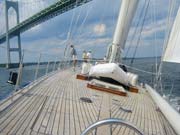International Marine Surveyors
specialists in large yacht surveys
refit & new construction supervision
- family heritage
Survey Tips - Preparing For Your Yacht's Survey
The following is a short list of items that should be checked on a regular basis. These are routine maintenance items commonly found during survey. (This is a guideline and not a complete list of items that will be checked during survey).

- Make sure the yacht is clean and neat, it makes it easier for the surveyor. Remember first impressions can be important.
- Check to be sure all relevant documents are on board and current. The surveyor will need to see documentation or registration papers. Also needed are documents for any dingies, PWC's, or motorized vehicles on board.
- A yacht captain will be required to run the yacht.
- Any construction drawings or manuals that can be provided may prove to be helpful to the surveyor.
- Check all U.S. Coast Guard items required for your class of yacht.
- Flares - make sure they are in date. Dates are on each flare.
- Fire extinguishers - proper number, mounted in brackets with current inspection tags. Must be tagged and inspected annually.
- Ship's bell on board.
- One approved Personal Flotation Device (PFD) in good condition for each person on board.
- As a minimum, there be must be one PFD for each bunk.
- Check all running lights.
- Make sure whistle (horn) works.
- There must be a copy of the Rules of the Road aboard.
- Check anchor and rode, safety wire shackles, and proper splice in the rode with thimble and bitter end secured.
- If there is an automatic fire extinguishing system, it must be in date - an annual requirement. Also make sure that the hydro date on the bottle is current - this is stamped on the bottle and is good for five years.
- All bilge pumps and automatic float switches must be working. All manual switches must be working.
- Check all alarms - bilge, fire, smoke, engine, generator, and electrical.
- Check all raw water hoses for age. If the hoses crack when you bend them, they need replacement. If they are soft or oil soaked, they need replacement.
- Make sure all the raw water hoses below the water line or under pressure are double clamped at both ends.
- Check all sea cocks or sea valves for easy operation and any leaks.
- Check exhaust hoses for age. All hose ends must be double clamped. If using ordinary screw type clamps, they really should be triple clamped.
- Check all hose clamps through out for rusting.
- Check main packing glands and rudder stuffing boxes for any excessive leakage.
- Bilges should be clean and dry.
- Check main engines and generators for oil and water. Also make sure start batteries are in good condition.
- Life rafts and hydrostatic releases must have inspection papers.
- EPIRBS must be in date. The batteries must be changed on a regular basis.
- Make sure all navigation and communication equipment is in good condition and operational. This includes the compass, which should have a current deviation card. This is done annually.
© Copyright 2025 - All Rights Reserved
World Yacht Surveyors - Pliske Marine, Inc.
A Fort Lauderdale Based Yacht Surveying Company
World Yacht Surveyors - Pliske Marine, Inc.
A Fort Lauderdale Based Yacht Surveying Company



